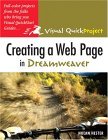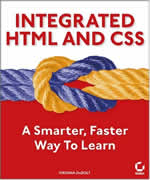 Creating a Web Page in Dreamweaver is the second Visual QuickProject I’ve seen from Peachpit Press. The author is Nolan Hester. Like the HTML Visual QuickProject I reviewed earlier, this book is stripped down to 125 pages, uses visuals as much as text to get the point across, and would enable a beginner to create a set of linked pages and get them up on the web.
Creating a Web Page in Dreamweaver is the second Visual QuickProject I’ve seen from Peachpit Press. The author is Nolan Hester. Like the HTML Visual QuickProject I reviewed earlier, this book is stripped down to 125 pages, uses visuals as much as text to get the point across, and would enable a beginner to create a set of linked pages and get them up on the web.
These Visual QuickProjects aren’t meant to create power users, so they would not be suitable for a full semester text. They would be perfect for someone who simply wants a basic, non-commercial page, or for a class of only a few hours in a situation like continuing ed. I’ve seen high school courses where the students are expected to be exposed to Dreamweaver, some image editing program like Fireworks, Flash, a video editing program, and possibly even something like PowerPoint. These little books would be a good introduction to an application program in a class like that.
The QuickProject includes a few Dreamweaver interface basics, a few text formatting basics, images, tables, lists, links, library items, templates, and publication. The project uses CSS styles and CSS for layout with both external and embedded styles.

 Creating a Web Page in Dreamweaver
Creating a Web Page in Dreamweaver